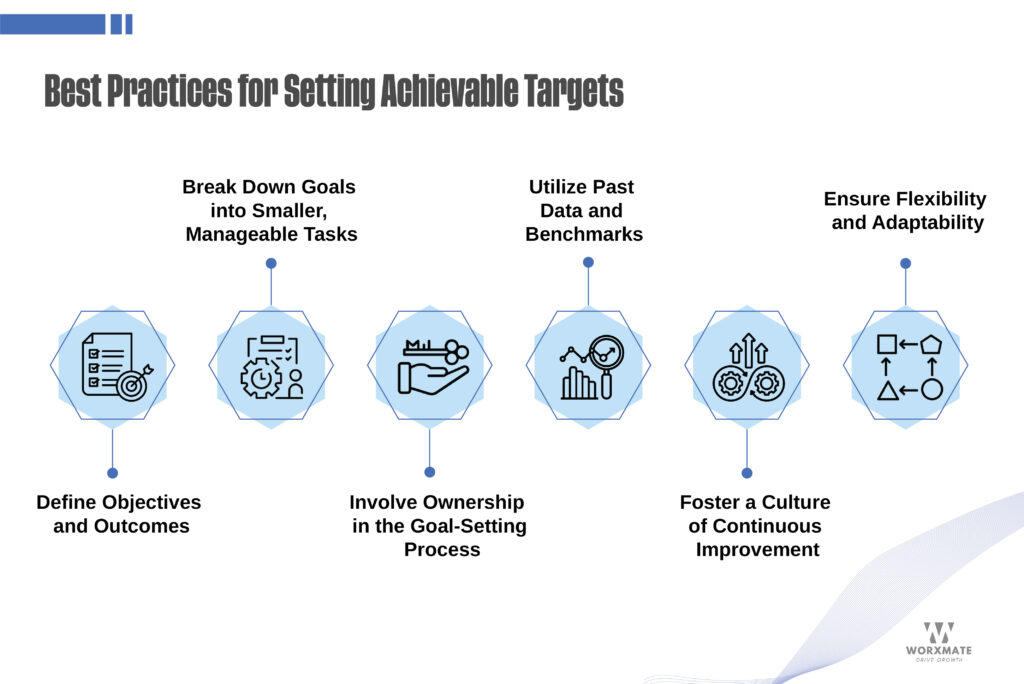Setting and tracking key results are fundamental aspects of goal management that drive organizational success. Without a clear understanding of what needs to be achieved and how progress will be measured, teams struggle to stay focused and aligned with overarching objectives.
Key results are tangible and measurable outcomes that indicate progress toward achieving broader objectives. It’s essential to differentiate between key results and key performance indicators (KPIs), as key results focus on specific outcomes related to strategic goals, while KPIs are indicators used to measure performance in various areas of the organization. Aligning key results with organizational goals ensures that efforts are directed toward the most critical priorities, driving alignment and accountability across the organization.

Best Practices for Setting Achievable Targets
-
-
Define Objectives and Outcomes
- Clear objectives serve as guiding lights, providing a clear direction for teams to follow.
- Unclear or ambiguous goals can lead to confusion and wasted efforts, hampering progress.
- Clarity ensures that everyone understands the purpose and desired outcome of the targets they are working towards.
- The SMART framework offers a structured approach to goal-setting, ensuring that targets are Specific, Measurable, Achievable, Relevant, and Time-bound.
- Specific goals provide clear direction, measurable goals enable progress tracking, achievable goals set realistic expectations, relevant goals align with broader objectives, and time-bound goals establish deadlines for completion.
- By adhering to the SMART criteria, organizations can avoid setting vague or unrealistic targets, increasing the likelihood of success.
-
Break Down Goals into Smaller, Manageable Tasks
- Splitting larger goals into smaller, manageable tasks makes them more approachable and less daunting for teams.
- It allows for a clearer understanding of the steps needed to achieve the overarching goal, facilitating better planning and resource allocation.
- Accomplishing smaller tasks provides a sense of progress and achievement, boosting motivation and morale within the team.
- Divide large goals into smaller sub-goals or milestones, creating a hierarchical structure that outlines the path to success.
- Utilize project management software or tools like Gantt charts to visually map out tasks, dependencies, and timelines.
- Collaboratively brainstorm with team members to identify and prioritize tasks, leveraging collective expertise and insights.
-
Involve Ownership in the Goal-Setting Process
- Stakeholder involvement fosters ownership and commitment towards achieving the set targets.
- When stakeholders are engaged from the beginning, they are more likely to support and actively contribute to the success of the initiative.
- Their input ensures that goals are aligned with organizational priorities and take into account diverse perspectives and concerns.
- Host workshops or meetings where stakeholders can come together to discuss goals, share insights, and provide feedback.
- Request feedback from stakeholders through surveys, interviews, or dedicated feedback sessions to gather valuable input and address any concerns.
- Clear communication channels: Establish open and transparent communication that keeps stakeholders informed and engaged throughout the goal-setting process, fostering a sense of inclusivity and collaboration.
-
Utilize Past Data and Benchmarks
- Analyzing past performance data provides valuable insights into what has worked well and what areas need improvement.
- It helps identify trends, patterns, and areas of strength or weakness, enabling organizations to make informed decisions when setting future targets.
- By learning from past experiences, organizations can avoid repeating mistakes and capitalize on successful strategies, increasing the likelihood of achieving desired outcomes.
- Comparing performance metrics against industry benchmarks allows organizations to gauge their competitiveness and identify areas for improvement.
- Benchmarking provides a benchmark for performance excellence, guiding organizations toward setting ambitious yet realistic targets.
- It enables organizations to stay informed about industry trends and best practices, ensuring that their targets are aligned with external standards and expectations.
-
Ensure Flexibility and Adaptability
- External factors such as market dynamics, regulatory changes, or technological advancements can impact the achievability of targets.
- Setting targets with built-in flexibility allows organizations to adapt to changing circumstances and navigate unforeseen challenges effectively.
- Flexibility enables teams to adjust their approach or priorities as needed, ensuring that targets remain relevant and achievable in dynamic environments.
- Conducting regular reviews allows organizations to assess progress, identify obstacles, and make necessary adjustments to targets or strategies.
- By adopting an agile approach to goal-setting, organizations can respond quickly to changes and capitalize on emerging opportunities.
- Regular reviews ensure that targets remain aligned with organizational priorities and evolving market conditions, increasing the likelihood of success in achieving desired outcomes.
-
Foster a Culture of Continuous Improvement
- A culture that values learning and innovation encourages experimentation, creativity, and the pursuit of excellence.
- Encouraging teams to explore new approaches, technologies, or methodologies fosters continuous improvement and drives organizational growth.
- Learning from successes and failures enables organizations to iterate and refine their strategies, staying ahead of the curve in a rapidly evolving landscape.
- Celebrating achievements and milestones acknowledges the hard work and dedication of teams, boosting morale and motivation.
- Recognizing and rewarding progress reinforces a culture of high performance and encourages ongoing effort toward achieving targets.
- Celebrations serve as opportunities for reflection and appreciation, strengthening team cohesion and commitment to shared goals.
-
Conclusion
Setting and tracking achievable targets is essential for driving organizational success. By clearly defining objectives, breaking down goals, involving stakeholders, utilizing past data, ensuring flexibility, fostering a culture of continuous improvement, and implementing effective tracking strategies, organizations can enhance their ability to achieve desired outcomes and stay competitive in today’s dynamic market.



